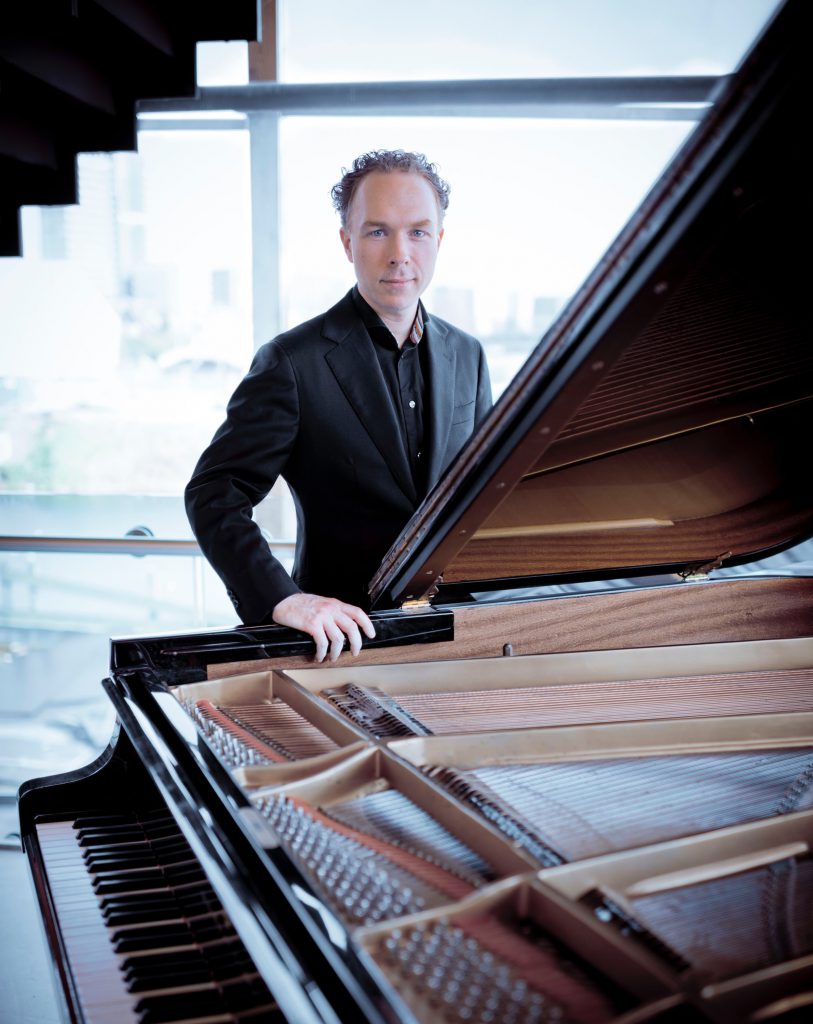Van Raat offers a piano feast, from Alkan and Ives to a Boulez premiere

Ralph van Raat performed at Weill Recital Hall Wednesday night. Photo: Simon Van Boxtel
Ralph van Raat is known as a champion of contemporary music, with fine recordings (on the Naxos label) of John Adams, Arvo Pärt, Magnus Lindberg, and Fred Rzewski among others.
The Dutch pianist’s Weill Recital Hall concert Wednesday night showed him as something else—a historically minded synthesizer. Through his programming and his remarks from the stage he attempted to bring together widely disparate music from older musical periods to the contemporary. If his arguments didn’t completely convince, the concert was still full of fascinations.
One was the music itself, a collection of the unusual and the rare. Van Raat opened with the world premiere of Louis Andriessen’s etude, Searching for Unison. He followed with Charles Valentin Alkan’s Symphony for Solo Piano, Debussy’s Etude retrouvée, and the first U.S. performance (and only second overall), of Prélude, Toccata, et Scherzo, by a teenaged Pierre Boulez.
Van Raat spoke freely and candidly from the stage, advocating for the music while also at times acknowledging that not every moment would be masterful. He introduced the Andriessen etude with the amusing anecdote that the composer wanted to explore working with unisons, then eventually realized that, with only one key per pitch, unison is impossible on the piano.
Searching for Unison, as van Raat described, was a four-minute retrospective of Andriessen’s creative career. It begins with a 12-tone row, skated over modernist expressionism and neo-romanticism, then concluded with basic, pure, repetitive minimalism, before leaving itself hanging with a single, forte suspended pitch. As a concise musical biography, the etude worked, but that the opening dodecaphony was the most alluring part said it all about the musical satisfactions.
Van Raat heard Alkan as something of a proto-modernist who explored the possibilities of consecutive minor seconds and dissonant clusters, likening him to Charles Ives. The Symphony is culled from the composer’s 12 Etudes in All the Minor Keys, Op. 39, music that demands a good deal of technical power and endurance from the pianist. Van Raat handled all the notes, but his advocacy for the piece as equal to Chopin and Liszt fell short, which was not his fault. As he acknowledged, Alkan can be mechanical and, indeed, there is a rote quality to his forms and a general stiffness to his composing that no artist could solve. Alkan, famously socially withdrawn, studiously avoided the human touch in his work.
After intermission, van Raat turned to the French repertoire. Debussy’s etude was only discovered in the late 20th century. It is an alternate version of his etude “Pour les Arpèges composés,” and although the composer sent it to his publisher, it was never put into print. It is worthy company to the published Etudes, especially as heard in the pianist’s lovely, fluid performance, spinning off gradually into a reverie lost in its own thoughts.
The Prélude, Toccata, et Scherzo is another posthumous work. Boulez wrote it in 1944, at age 19, and never wanted it published nor performed in his lifetime. Now, since his death, his heirs have assented. It was van Raat who delivered the world premiere earlier this fall, and one expects other pianists to tackle this piece, as it is both fascinating and impressive.
The teenage Boulez was clearly as aesthetically rigorous and ascetic as he was through most of his mature career, but had not yet embraced the ideology of serial atonality. And so this early work is severe and modernist in the way of Copland’s Piano Sonata, though much denser harmonically and expressively. The influence of Bartók is clear but not dominant.
Van Raat knew how to play the bass lines, clusters, and accents in a way that sounded both like Bartók and Boulez, with the right technique and the urban attitude of Boulez. And once past the Prélude, the piece is all Boulez.
And impressively so. The Toccata and Scherzo were exciting and involving exactly because they use a minimum of material with utter conviction, and van Raat’s insistent playing hit some thrilling moments. The Toccata states itself and then the music does its best to fly apart, but in the end it is held together by its own gravity. The final movement is something of a cubist Scherzo, a combination of sharp angles and flat surfaces, with a unique trio section that delves into mysticism. This was a bracing performance of a bracing work.
For his encore, van Raat delivered a true synthesis of past and present via modernism, with a terrific performance of the “Alcott” movement from Ives’ Concord Sonata. The pianist etched a satisfying contrast between the complex passions of Ives’ use of Beethoven’s famous Fifth Symphony motif, and the composer’s own tender “Human Faith” theme. Lovely and moving in every way, it makes one eager to hear van Raat tackle Ives’ entire sonata.
The St. Lawrence String Quartet and pianist Inon Barnatan play Haydn, Beethoven, and Shostakovich in Zankel Hall 7:30 p.m. November 8. carnegiehall.org